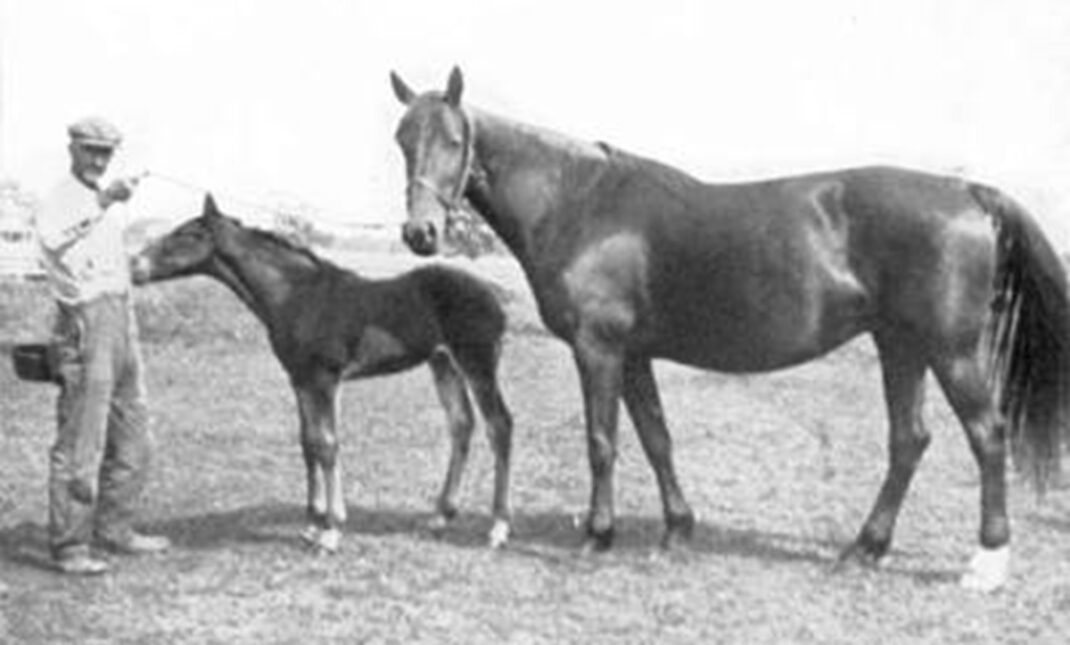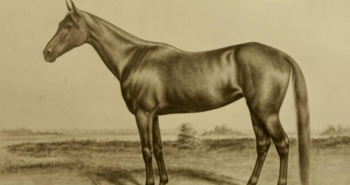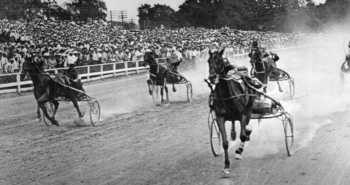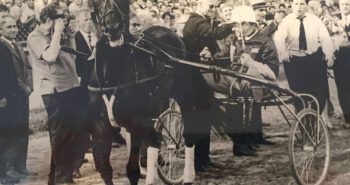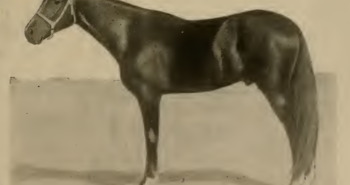The first dam of three 2:05 trotters, her mating was the result of chance. Even though Nervolo Belle was never even trained, she went on to achieve fame as a broodmare and also produced one of harness racing’s biggest names in Peter Volo.
The story of Nervolo Belle starts in many ways when Grant Lee (“GL”) Knight bought Mambrino Beauty at the first day of the Woodard & Shanklin auction in Lexington, KY, on Jan 9, 1893. A beautiful chestnut mare, Mambrino Beauty was a daughter of Mambrino King and Beulah, the latter often simply referred to as an “Allie West mare” in reference to her sire, a paternal grandson of Alexander’s Abdallah. Mambrino Beauty was unstarted but showed promise as a broodmare as she had already produced pacer HR Hiatt p2:17, by Mohican. In the spring of 1893, Knight bred his mare to Betterton, a son of George Wilkes who stood stud at Ash Grove Farm in Lexington.
His choice of stallion was probably inspired by Mambrino Beauty’s then-two-year-old daughter by Betterton. That filly, Betty King, was bred by ZT Chrisman’s Jessamine Stock Farm, a farm Knight was familiar with. Knight was a banker with the First National Bank and when Chrisman went bankrupt in 1894, Knight’s bank was one of the biggest creditors. Furthermore, at the WR Brasfield auction the previous year in Lexington, on Feb 4, 1892, Knight had bought the broodmare Alpena from the consignment of Jessamine Stock Farm. Another horse in that consignment was Betty King, who was sold to AY Art of Hartford, Iowa, for $525. Although it could have been a coincidence, it seems likely that Knight was well aware of Betty King and that she inspired the choice of Betterton. In the spring of 1894, Mambrino Beauty gave birth to a filly named Josephine Knight, presumably for a family member. That summer her older full sister impressed in Iowa before tragedy struck. In August newspapers reported “the 3-year-old trotter Betty King, time 2:20, owned by AY Art and valued at $5,000, burst a blood vessel and expired while being driven a fast mile at the Capital City Driving park” in Des Moines on Aug 17, 1894. In 1895, Grant Lee Knight and his wife had a daughter who was also named Josephine, but tragically she died the following year.
Pink eye
According to an unpublished manuscript on the history of Almahurst Farm, done for former owner Jack Baugh, Knight “wished to race the filly and placed her at age two in the stable of Will Young. Unfortunately she contracted pink eye which ended her training and her sight as well.” Josephine Knight then ended up as a broodmare, and she had three foals prior to 1905. One of these was Mary Burton, a daughter of Warlock born in 1900, from which Belina Josselyn descends. However, Knight really struck gold with Josephine Knight’s fourth foal, Nervolo Belle. In the unpublished manuscript Henry Knight, son of Grant Lee, retold the story of how the breeding of Josephine Knight to Nervolo came about: “Early one morning in 1905 my dad sent me with his standardbred mare Josephine Knight to have her bred to the famous blind stallion Rhythmic 2:06 3/4 (1.18,8) at the Jesse Turney Farm at Paris, Kentucky. My uncle Scott Hudson had campaigned the horse and my dad thought highly of him. However there had been a mix up and Rhytmic’s book was full and not wanting to make the trip for nothing, and whereas Mr Turney did not believe in telephones, I could not call home. Therefore I had Josephine Knight bred to Nervolo p2:04 1/4 who was there at the farm. He having also been in my uncle’s stable at one time. From the mating we got the filly Nervolo Belle.”
Nervolo was a bloodlike looking horse and first class free-legged pacer with an excellent career on the Grand Circuit. Nervolo also had the dubious honor of receiving mistreatment that led to a rule change. In The Tennessee 2:08 Pace at Lexington on Oct 8, 1903, driver Scott Hudson put a battery under the sulky seat and gave Nervolo electric shocks in the race: “that day at Lexington, when he first felt the electric current cursing along his spinal column he showed a burst of speed that astonished the natives.” Hudson argued it was ok because there was nothing in the rules specifically banning the use of batteries. However, after the trotter Riley B suffered the same three days later, the Breeders’ Association immediately changed to the rulebook to expliitly ban the use of batteries. Nervolo died in Richwood, OH on Jan 25, 1923. He was then 26 years old and had produced four pacers in the 2:10 list. However, his claim to fame is all because of the unstarted daughter Nervolo Belle.
Sent home
Nervolo Belle was sent to Scott Hudson, but didn’t last long. Says Henry Knight: “My dad thought very little of her, but did consent after much discussion to have uncle Scott train her as he was co-breeder with my dad. She became quite ill before her training had advanced very far and was sent home (…) She later passed into sole ownership of William Knight, and when he died a few years later the mare was given to his sister Carrie Knight who had nursed the filly back to health when she became so ill while in training. The remedy is rumoured to be raw eggs and a liberal amount of good Kentucky bourbon.”
At some point there was a rumor that Nervolo Belle, before being put to breeding, had been a very fast pacer in the training of Hudson and supposedly trialed in 2:11 3/4 (1.21,9) as a three-year-old. Henry Knight, brother of WP Knight, was insistent that the rumor was false. He was adamant that Nervolo Belle was never properly trained nor raced in any time trial, at any time. Furthermore, she was a trotter and never showed any pacing inclination.
Becoming legendary
After being nursed back with the raw eggs and bourbon, Nervolo Belle was bred at 3 to Peter O’Donna 2:08, a son of Peter the Great. The following year she gave birth to Donna Volo p2:19 1/4 (1.26,5), and Nervolo Belle was then bred to Peter the Great. The latter produced Peter Volo. Peter Volo sent world records at 1, 2, 3 and 4, and only lost one racing in his life. He also won the 1914 Kentucky Futurity and later became a legendary stallion. Two years later Nervolo Belle delivered a full sister to Peter Volo when the magnificent chestnut mare Volga E., a winner of the 1916 Kentucky Futurity, was born. Nervolo Belle thus became the first dam of two Kentucky Futurity winners.
By that time, Nervolo Belle was no longer with the Knight family. In late May 1916 Nervolo Belle was sold to Stoughton A Fletcher at the Laurel Hall Farm in Indianapolis, not long after he had bought Peter the Great from Patchen Wilkes Farm. Fletcher paid $10,000 for the 10-year-old mare, who continued to deliver talented foals. In the four years following her sale, Nervolo Belle delivered The Great Miss Morris, The Great Volo, The Great Midwest and Vologda, all by Peter the Great. Of these The Great Volo was an elite trotter who won several Grand Circuit races at the high level. His record was 2:02 1/4 (1.16,0), but several contemporaries believed the colt was a potential 2:00 (1.14,6) trotter. The Great Miss Morris was also a very good dual-gaited horse with a 2:07 1/4 (1.19,1) trotting mark and a 2:18.2 (1.26,0) clocking on the pace. She became a very good broodmare and was the dam of the stellar two-year-old of 1933, Sturdy. The latter had not been kept eligible to the Hambletonian and was therefore sold to Germany at 3. He later became one of the many horses stolen from Charley Mills’ stable a few days before WWII ended. More recent stars tracing back to The Great Miss Morris including Napoletano Check Me Out and King of the North, Shadow Play and JK Endofanera.
Volga E left an even bigger legacy than her younger sister. Her first-born, Jane Revere, gave birth to Alma Lee, the dam of Rosalind. Stars like Corleone Kosmos, Flak Bait, Googoo Gaagaa and the pacer Jereme’s Jet are among many top trotters hailing from his branch. Her last daughter, China L, became one of the foundation mares of Charlie Keller’s Yankeeland farms, and stars like Muscle Hill, Windsong’s Legacy, TV Yankee and Yankee Glide trace back to her on this maternal line. Other stars tracing back to Volga E through other daughters include the German Elitlopp-winner Brioni, Donato Hanover, Kadabra, the Italian Mack Grace SM, the pacer Pacific Rocket, and Snow White..
Another daughter, Lullavolo established a successful maternal line in Norway after her daughter Yardley was exported there in late 1935. Standouts from this branch include Tamin Sandy 4.1;.55.4f, winner of the 1993 European Championship for 3-year-olds and 1993 Gran Premio Orsi Mangelli, and Bunny 1:53.2f, third in the 2024 European Championship for Mares.
Nervolo Belle had also earlier produced Worthy Volo 2,2:08 3/4 (1.20,0) and Axwolo 4,2:07 3/4 (1.19,4). By doing so she put a whopping six foals in the 2:10 list – this at a time when many mares failed to produce a single 2:10 trotter.
Not too much is known these days about Nervolo Belle herself, but it stands to reason the mare most likely had a bad disposition: both her sire Nervolo and his second-born Peter Volo were known for their terrible tempers.
Escaping death
In the latter years of her life she was bought by the late William Monroe Wright and added to his Calumet Farm stud, where her last foals were born. Though generally easy to get in foal, Nervolo Belle was not in foal during the winter of 1926. That proved to be a stroke of luck. According to the Lexington Herald on Mar 3, 1926, “a case where misfortune turned to be a good fortune is offered by Nervolo Belle and Sienna 2:06 3/4 (1.18,8), the two greatest of all broodmares, at Calumet Farm. Both proved empty this spring, which early seemed like a great misfortune but later proved a blessing for if they had been with foal they would likely have been in the broodmare barn which burned. Their paddock companion is Widow Maggie, dam of Mr McElwyn.”
| Year | Name | Sire | Career | Other info |
|---|---|---|---|---|
| 1910 | Donna Volo (f) | Peter O’Donna | p2:19 1/4 (1.26,5) | |
| 1911 | Peter Volo (c) | Peter the Great | 4,2:02 (1.15,8) | Winner 1914 Kentucky Futurity |
| 1912 | Petress Volo (f) | Peter the Great | 2,2:27 1/4 (1.31,5) | |
| 1913 | Volga E (f) | Peter the Great | 3,2:04 1/2 (1.17,4) | Winner 1916 Kentucky Futurity |
| 1914 | Worthy Volo (c) | Axworthy | 2,2:08 3/4 (1.20,0) | |
| 1915 | Axvolo (c) | Axworthy | 4,2:07 3/4 (1.19,4) | |
| 1916 | Moko Volo (c) | Moko | Exported to Germany | |
| 1917 | The Great Miss Morris (f) | Peter the Great | p4,2:18.2 (1.26,0) 4,2:07 1/4 (1.19,1) | |
| 1918 | The Great Volo (c) | Peter the Great | 2:02 1/4 (1.16,0) | |
| 1919 | The Great Midwest (c) | Peter the Great | 2,2:16 1/2 (1.24,8) | Exported to Germany |
| 1920 | Vologda (c) | Peter the Great | 3,2:15 3/4 (1.24,4) | |
| 1921 | Queenie Volo (f) | Peter Volo | ||
| 1925 | Lullavolo (f) | The Senator | 2:15 (1.23,9) | |
| 1933 | Calumet Belfast (f) | Peter the Brewer |
Hall of Famer
On Apr 9, 1935, Grant Lee Knight died, 70 years old. In his will he had stipulated that Nervolo Belle should be taken to Almahurst Farm, so that she may pass away at her birthplace. That was not fulfilled, however, as she passed away at Calumet Farms exactly two months later. In Peter Volo 2:02 (1.15,8), Volga E 2:04 1/2 (1.17,4) and The Great Volo 2:02 1/4 (1.16,0), Nervolo Belle was the first dam of three 2:05 (1.17,7) trotters and the first dam of two Kentucky Futurity winners.
Nervolo Belle was inducted into the Hall of Fame in 1966.
nervolo belle
Bay filly born in Nicholasville, KY in 1906. Died in Lexington KY on Jun 9, 1935.
Nervolo – Josephine Knight (Betterton)
unstarted
Breeders: Grant Lee Knight & Scott Hudson
Owners: Grant Lee Knight & Scott Hudson – WP Knight – Carrie Knight – Stoughton A Fletcher – Calumet Farm
Trainer: Scott Hudson
Driver: –
Groom: –

